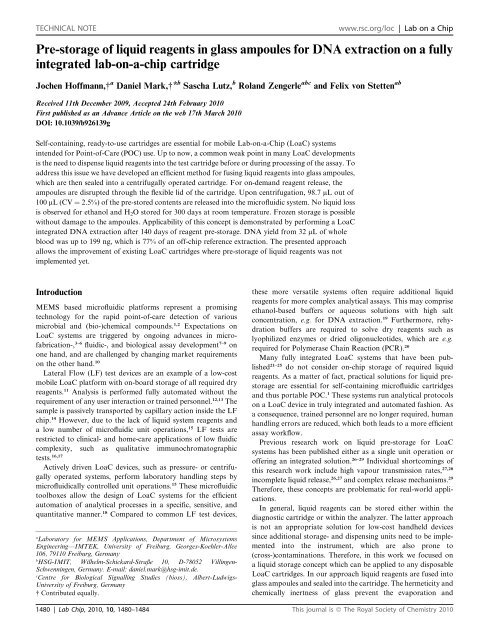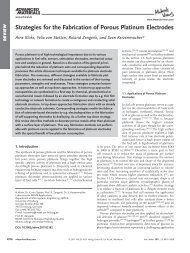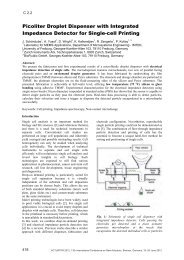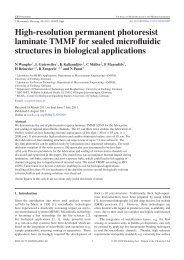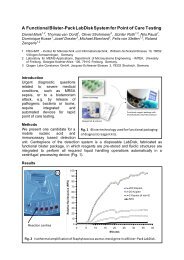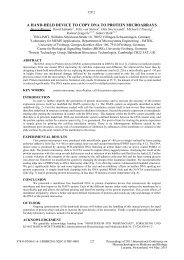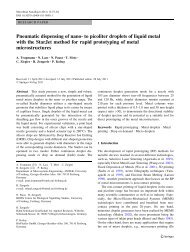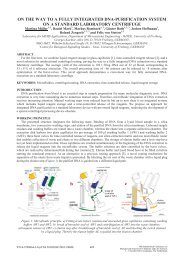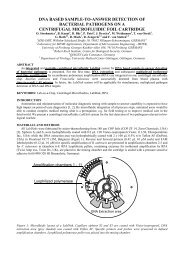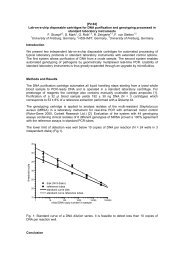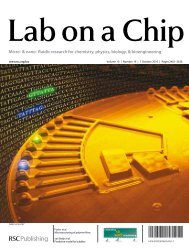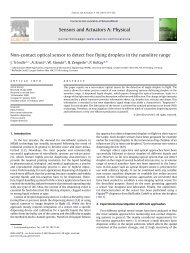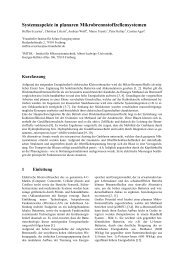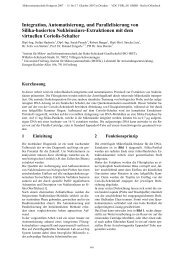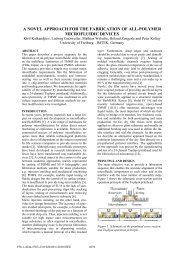Pre-storage of liquid reagents in glass ampoules for DNA ... - IMTEK
Pre-storage of liquid reagents in glass ampoules for DNA ... - IMTEK
Pre-storage of liquid reagents in glass ampoules for DNA ... - IMTEK
You also want an ePaper? Increase the reach of your titles
YUMPU automatically turns print PDFs into web optimized ePapers that Google loves.
TECHNICAL NOTE<br />
www.rsc.org/loc | Lab on a Chip<br />
<strong>Pre</strong>-<strong>storage</strong> <strong>of</strong> <strong>liquid</strong> <strong>reagents</strong> <strong>in</strong> <strong>glass</strong> <strong>ampoules</strong> <strong>for</strong> <strong>DNA</strong> extraction on a fully<br />
<strong>in</strong>tegrated lab-on-a-chip cartridge<br />
Jochen H<strong>of</strong>fmann,† a Daniel Mark,†* b Sascha Lutz, b Roland Zengerle abc and Felix von Stetten ab<br />
Received 11th December 2009, Accepted 24th February 2010<br />
First published as an Advance Article on the web 17th March 2010<br />
DOI: 10.1039/b926139g<br />
Self-conta<strong>in</strong><strong>in</strong>g, ready-to-use cartridges are essential <strong>for</strong> mobile Lab-on-a-Chip (LoaC) systems<br />
<strong>in</strong>tended <strong>for</strong> Po<strong>in</strong>t-<strong>of</strong>-Care (POC) use. Up to now, a common weak po<strong>in</strong>t <strong>in</strong> many LoaC developments<br />
is the need to dispense <strong>liquid</strong> <strong>reagents</strong> <strong>in</strong>to the test cartridge be<strong>for</strong>e or dur<strong>in</strong>g process<strong>in</strong>g <strong>of</strong> the assay. To<br />
address this issue we have developed an efficient method <strong>for</strong> fus<strong>in</strong>g <strong>liquid</strong> <strong>reagents</strong> <strong>in</strong>to <strong>glass</strong> <strong>ampoules</strong>,<br />
which are then sealed <strong>in</strong>to a centrifugally operated cartridge. For on-demand reagent release, the<br />
<strong>ampoules</strong> are disrupted through the flexible lid <strong>of</strong> the cartridge. Upon centrifugation, 98.7 mL out <strong>of</strong><br />
100 mL (CV ¼ 2.5%) <strong>of</strong> the pre-stored contents are released <strong>in</strong>to the micr<strong>of</strong>luidic system. No <strong>liquid</strong> loss<br />
is observed <strong>for</strong> ethanol and H 2 O stored <strong>for</strong> 300 days at room temperature. Frozen <strong>storage</strong> is possible<br />
without damage to the <strong>ampoules</strong>. Applicability <strong>of</strong> this concept is demonstrated by per<strong>for</strong>m<strong>in</strong>g a LoaC<br />
<strong>in</strong>tegrated <strong>DNA</strong> extraction after 140 days <strong>of</strong> reagent pre-<strong>storage</strong>. <strong>DNA</strong> yield from 32 mL <strong>of</strong> whole<br />
blood was up to 199 ng, which is 77% <strong>of</strong> an <strong>of</strong>f-chip reference extraction. The presented approach<br />
allows the improvement <strong>of</strong> exist<strong>in</strong>g LoaC cartridges where pre-<strong>storage</strong> <strong>of</strong> <strong>liquid</strong> <strong>reagents</strong> was not<br />
implemented yet.<br />
Introduction<br />
MEMS based micr<strong>of</strong>luidic plat<strong>for</strong>ms represent a promis<strong>in</strong>g<br />
technology <strong>for</strong> the rapid po<strong>in</strong>t-<strong>of</strong>-care detection <strong>of</strong> various<br />
microbial and (bio-)chemical compounds. 1,2 Expectations on<br />
LoaC systems are triggered by ongo<strong>in</strong>g advances <strong>in</strong> micr<strong>of</strong>abrication-,<br />
3–6 fluidic-, and biological assay development 7–9 on<br />
one hand, and are challenged by chang<strong>in</strong>g market requirements<br />
on the other hand. 10<br />
Lateral Flow (LF) test devices are an example <strong>of</strong> a low-cost<br />
mobile LoaC plat<strong>for</strong>m with on-board <strong>storage</strong> <strong>of</strong> all required dry<br />
<strong>reagents</strong>. 11 Analysis is per<strong>for</strong>med fully automated without the<br />
requirement <strong>of</strong> any user <strong>in</strong>teraction or tra<strong>in</strong>ed personnel. 12,13 The<br />
sample is passively transported by capillary action <strong>in</strong>side the LF<br />
chip. 14 However, due to the lack <strong>of</strong> <strong>liquid</strong> system <strong>reagents</strong> and<br />
a low number <strong>of</strong> micr<strong>of</strong>luidic unit operations, 15 LF tests are<br />
restricted to cl<strong>in</strong>ical- and home-care applications <strong>of</strong> low fluidic<br />
complexity, such as qualitative immunochromatographic<br />
tests. 16,17<br />
Actively driven LoaC devices, such as pressure- or centrifugally<br />
operated systems, per<strong>for</strong>m laboratory handl<strong>in</strong>g steps by<br />
micr<strong>of</strong>luidically controlled unit operations. 15 These micr<strong>of</strong>luidic<br />
toolboxes allow the design <strong>of</strong> LoaC systems <strong>for</strong> the efficient<br />
automation <strong>of</strong> analytical processes <strong>in</strong> a specific, sensitive, and<br />
quantitative manner. 18 Compared to common LF test devices,<br />
a<br />
Laboratory <strong>for</strong> MEMS Applications, Department <strong>of</strong> Microsystems<br />
Eng<strong>in</strong>eer<strong>in</strong>g—<strong>IMTEK</strong>, University <strong>of</strong> Freiburg, Georges-Koehler-Allee<br />
106, 79110 Freiburg, Germany<br />
b<br />
HSG-IMIT, Wilhelm-Schickard-Straße 10, D-78052 Vill<strong>in</strong>gen-<br />
Schwenn<strong>in</strong>gen, Germany. E-mail: daniel.mark@hsg-imit.de.<br />
c<br />
Centre <strong>for</strong> Biological Signall<strong>in</strong>g Studies (bioss), Albert-Ludwigs-<br />
University <strong>of</strong> Freiburg, Germany<br />
† Contributed equally.<br />
these more versatile systems <strong>of</strong>ten require additional <strong>liquid</strong><br />
<strong>reagents</strong> <strong>for</strong> more complex analytical assays. This may comprise<br />
ethanol-based buffers or aqueous solutions with high salt<br />
concentration, e.g. <strong>for</strong> <strong>DNA</strong> extraction. 19 Furthermore, rehydration<br />
buffers are required to solve dry <strong>reagents</strong> such as<br />
lyophilized enzymes or dried oligonucleotides, which are e.g.<br />
required <strong>for</strong> Polymerase Cha<strong>in</strong> Reaction (PCR). 20<br />
Many fully <strong>in</strong>tegrated LoaC systems that have been published<br />
21–25 do not consider on-chip <strong>storage</strong> <strong>of</strong> required <strong>liquid</strong><br />
<strong>reagents</strong>. As a matter <strong>of</strong> fact, practical solutions <strong>for</strong> <strong>liquid</strong> pre<strong>storage</strong><br />
are essential <strong>for</strong> self-conta<strong>in</strong><strong>in</strong>g micr<strong>of</strong>luidic cartridges<br />
and thus portable POC. 1 These systems run analytical protocols<br />
on a LoaC device <strong>in</strong> truly <strong>in</strong>tegrated and automated fashion. As<br />
a consequence, tra<strong>in</strong>ed personnel are no longer required, human<br />
handl<strong>in</strong>g errors are reduced, which both leads to a more efficient<br />
assay workflow.<br />
<strong>Pre</strong>vious research work on <strong>liquid</strong> pre-<strong>storage</strong> <strong>for</strong> LoaC<br />
systems has been published either as a s<strong>in</strong>gle unit operation or<br />
<strong>of</strong>fer<strong>in</strong>g an <strong>in</strong>tegrated solution. 26–29 Individual shortcom<strong>in</strong>gs <strong>of</strong><br />
this research work <strong>in</strong>clude high vapour transmission rates, 27,28<br />
<strong>in</strong>complete <strong>liquid</strong> release, 26,27 and complex release mechanisms. 29<br />
There<strong>for</strong>e, these concepts are problematic <strong>for</strong> real-world applications.<br />
In general, <strong>liquid</strong> <strong>reagents</strong> can be stored either with<strong>in</strong> the<br />
diagnostic cartridge or with<strong>in</strong> the analyzer. The latter approach<br />
is not an appropriate solution <strong>for</strong> low-cost handheld devices<br />
s<strong>in</strong>ce additional <strong>storage</strong>- and dispens<strong>in</strong>g units need to be implemented<br />
<strong>in</strong>to the <strong>in</strong>strument, which are also prone to<br />
(cross-)contam<strong>in</strong>ations. There<strong>for</strong>e, <strong>in</strong> this work we focused on<br />
a <strong>liquid</strong> <strong>storage</strong> concept which can be applied to any disposable<br />
LoaC cartridges. In our approach <strong>liquid</strong> <strong>reagents</strong> are fused <strong>in</strong>to<br />
<strong>glass</strong> <strong>ampoules</strong> and sealed <strong>in</strong>to the cartridge. The hermeticity and<br />
chemically <strong>in</strong>ertness <strong>of</strong> <strong>glass</strong> prevent the evaporation and<br />
1480 | Lab Chip, 2010, 10, 1480–1484 This journal is ª The Royal Society <strong>of</strong> Chemistry 2010
degradation <strong>of</strong> the encapsulated <strong>liquid</strong>s. The simple but reliable<br />
release mechanism guarantees a fast and def<strong>in</strong>ed open<strong>in</strong>g <strong>of</strong> the<br />
<strong>glass</strong> ampoule and a complete transfer <strong>of</strong> its content <strong>in</strong>to<br />
a micr<strong>of</strong>luidic system. Applicability <strong>of</strong> this approach is demonstrated<br />
by per<strong>for</strong>m<strong>in</strong>g a LoaC <strong>in</strong>tegrated <strong>DNA</strong> extraction after<br />
140 days <strong>of</strong> reagent pre-<strong>storage</strong>.<br />
Experimental<br />
Glass is an excellent material <strong>for</strong> long-term stable <strong>liquid</strong> encapsulation<br />
due to its vapour barrier properties as well as chemical<br />
<strong>in</strong>ertness towards biological and chemical compounds. As<br />
a material <strong>for</strong> the micr<strong>of</strong>luidic cartridge cyclic olef<strong>in</strong> copolymer<br />
(COC) is chosen due to its unique properties such as optical<br />
transparency, moisture barrier, high water vapour resistance and<br />
temperature resistance compared to other typical polymers. 30<br />
Functional pr<strong>in</strong>ciple and design<br />
Liquid-filled <strong>glass</strong> <strong>ampoules</strong> are sealed <strong>in</strong>to a micr<strong>of</strong>luidic<br />
cartridge. For reagent release, the <strong>ampoules</strong> are disrupted by<br />
locally exert<strong>in</strong>g mechanical <strong>for</strong>ce with a f<strong>in</strong>gertip through the<br />
elastic lid <strong>of</strong> the cartridge. Released content is centrifugally displaced<br />
<strong>in</strong>to the fluidic periphery through a filter structure<br />
<strong>in</strong>hibit<strong>in</strong>g <strong>glass</strong> shivers from be<strong>in</strong>g <strong>for</strong>warded <strong>in</strong>to the fluidic<br />
system (Fig. 1).<br />
Storage reservoirs hold<strong>in</strong>g 100 mL <strong>ampoules</strong> have dimensions<br />
<strong>of</strong> 16 mm 5.1 mm 5.1 mm. Filter structures consist <strong>of</strong> three<br />
quadratic (400 mm 400 mm) microchannels connect<strong>in</strong>g <strong>storage</strong><br />
reservoir and fluidic system.<br />
cartridge design was complemented by embedd<strong>in</strong>g all required<br />
<strong>reagents</strong> <strong>in</strong>to the modified disk. As depicted <strong>in</strong> Fig. 2, the selfconta<strong>in</strong><strong>in</strong>g<br />
cartridge comprises three <strong>glass</strong> <strong>ampoules</strong>, an <strong>in</strong>let<br />
reservoir, a silica extraction matrix, and a <strong>liquid</strong> switch<strong>in</strong>g<br />
chamber guid<strong>in</strong>g <strong>liquid</strong>s—depend<strong>in</strong>g on the sp<strong>in</strong>n<strong>in</strong>g direction—<br />
either to the waste reservoir or to the elution reservoir (purified<br />
<strong>DNA</strong>). 32 The <strong>glass</strong> <strong>ampoules</strong> conta<strong>in</strong> 100 mL <strong>of</strong> buffers (2 times<br />
wash<strong>in</strong>g buffer, 1 time elution buffer) and are <strong>in</strong>serted <strong>in</strong>to<br />
<strong>storage</strong> reservoirs, which are connected to the <strong>in</strong>let reservoir via<br />
the microchannel filter structure <strong>for</strong> hold<strong>in</strong>g back <strong>glass</strong> shivers.<br />
For on-chip <strong>DNA</strong> extraction 32 mL <strong>of</strong> pre-lyzed blood (total<br />
volume <strong>in</strong>clud<strong>in</strong>g blood, lysis buffer, and ethanol: 96 mL) are<br />
<strong>in</strong>serted <strong>in</strong>to the <strong>in</strong>let reservoir <strong>of</strong> the fluidic cartridge. The <strong>in</strong>let is<br />
then sealed by a self-adhesive foil and the rotational frequency<br />
protocol is started. After the lysate has seeped through the<br />
extraction matrix to b<strong>in</strong>d the <strong>DNA</strong>, it is centrifugally driven<br />
radially outwards and deflected by the Coriolis <strong>for</strong>ce 33,34 <strong>in</strong>to the<br />
waste reservoir. Then, the <strong>ampoules</strong> conta<strong>in</strong><strong>in</strong>g wash<strong>in</strong>g buffer<br />
are sequentially disrupted by f<strong>in</strong>ger-<strong>for</strong>ce while the disk is at rest.<br />
Upon consecutive rotation, the centrifugal <strong>for</strong>ce transfers<br />
released wash<strong>in</strong>g buffers through the extraction matrix wash<strong>in</strong>g<br />
away cell debris and prote<strong>in</strong>s. These buffers are also deflected<br />
<strong>in</strong>to the waste reservoir by the Coriolis <strong>for</strong>ce. As a last step, the<br />
ampoule hold<strong>in</strong>g the elution buffer is crushed and the sp<strong>in</strong>n<strong>in</strong>g<br />
direction reversed. <strong>DNA</strong> bound to the extraction matrix is eluted<br />
and now deflected <strong>in</strong>to the elution reservoir. The amount <strong>of</strong><br />
<strong>DNA</strong> is measured us<strong>in</strong>g the <strong>DNA</strong> quantitation plat<strong>for</strong>m<br />
QuibitÔ (Invitrogen GmbH, Karlsruhe, Germany).<br />
<strong>DNA</strong> extraction cartridge<br />
Genomic <strong>DNA</strong> is extracted from the blood <strong>of</strong> a healthy lab<br />
member with<strong>in</strong> a fully <strong>in</strong>tegrated LoaC cartridge us<strong>in</strong>g components<br />
<strong>of</strong> a commercial <strong>DNA</strong>-extraction kit (QIAamp <strong>DNA</strong><br />
Blood Kit M<strong>in</strong>i 250, Qiagen, Hilden, Germany). The extraction<br />
protocol given by the supplier has been previously trans<strong>for</strong>med<br />
<strong>in</strong>to micr<strong>of</strong>luidic unit operations, 15 which are realized by a disk<br />
shaped micr<strong>of</strong>luidic cartridge. 31 In this work, the exist<strong>in</strong>g<br />
Fig. 1 Schematics <strong>of</strong> <strong>storage</strong> and release with<strong>in</strong> a centrifugally operated<br />
LoaC system: (a) enclosed air bubble, (b) filter structure consist<strong>in</strong>g <strong>of</strong><br />
400 mM wide bars <strong>for</strong> reta<strong>in</strong><strong>in</strong>g <strong>glass</strong> shivers, (c) <strong>glass</strong> ampoule, and<br />
(d) crushed <strong>glass</strong> ampoule.<br />
Fig. 2 LoaC cartridge <strong>for</strong> on-chip <strong>DNA</strong> extraction featur<strong>in</strong>g required<br />
buffers pre-stored <strong>in</strong> <strong>glass</strong> <strong>ampoules</strong>: (a) three <strong>glass</strong> <strong>ampoules</strong> conta<strong>in</strong><strong>in</strong>g<br />
buffers <strong>for</strong> <strong>DNA</strong> extraction (buffers are coloured <strong>for</strong> visualization<br />
purposes), (b) filter structures <strong>for</strong> reta<strong>in</strong><strong>in</strong>g <strong>glass</strong> shivers, (c) <strong>in</strong>let reservoir<br />
<strong>for</strong> <strong>in</strong>troduc<strong>in</strong>g the sample, (d) <strong>DNA</strong> extraction matrix, (e) <strong>liquid</strong><br />
switch<strong>in</strong>g chamber, (f) reservoir <strong>for</strong> waste, and (g) reservoir <strong>for</strong> the<br />
purified <strong>DNA</strong>.<br />
This journal is ª The Royal Society <strong>of</strong> Chemistry 2010 Lab Chip, 2010, 10, 1480–1484 | 1481
Fabrication <strong>of</strong> <strong>glass</strong> <strong>ampoules</strong><br />
The <strong>glass</strong> <strong>ampoules</strong> are fabricated from <strong>glass</strong> tubes (Borosilicate<br />
<strong>glass</strong>, Type 3.3, Hilgenberg, Malsfeld, Germany) <strong>of</strong> a length <strong>of</strong><br />
8 cm and an outer diameter <strong>of</strong> 5 mm featur<strong>in</strong>g a wall thickness <strong>of</strong><br />
70 mm. A micro-bunsen burner (Hilgenberg, Malsfeld, Germany)<br />
is used <strong>for</strong> trans<strong>for</strong>m<strong>in</strong>g <strong>glass</strong> tubes <strong>in</strong>to <strong>liquid</strong> conta<strong>in</strong><strong>in</strong>g<br />
<strong>ampoules</strong>. The double-nozzle burner provides a th<strong>in</strong> blue flame<br />
(diameter z 3 mm) with a maximum temperature <strong>of</strong> 1560 C.<br />
For produc<strong>in</strong>g <strong>liquid</strong>-filled <strong>glass</strong> <strong>ampoules</strong> the centre <strong>of</strong> the <strong>glass</strong><br />
tube is manually and slowly rotated <strong>in</strong> the flame until two vessels<br />
are obta<strong>in</strong>ed, which are closed at one side. Liquid samples are<br />
cooled down to the freez<strong>in</strong>g po<strong>in</strong>t to m<strong>in</strong>imize the impact <strong>of</strong> heat<br />
dur<strong>in</strong>g the subsequent fus<strong>in</strong>g process. Then, a volume <strong>of</strong> 100 mL<br />
is pipetted <strong>in</strong>to the vessel and the upright <strong>liquid</strong>-conta<strong>in</strong><strong>in</strong>g vessel<br />
is brought <strong>in</strong>to contact with the flame circa 8 mm above the<br />
<strong>liquid</strong> level. Upon shr<strong>in</strong>kage <strong>of</strong> the tube to about 50% <strong>of</strong> its<br />
diameter, the vessel is pulled out <strong>of</strong> the flame, cooled down to<br />
room temperature, and f<strong>in</strong>ally hermetically sealed by further<br />
heat<strong>in</strong>g. This repeated process <strong>of</strong> heat<strong>in</strong>g and cool<strong>in</strong>g reduces the<br />
impact <strong>of</strong> the heat on the encapsulated <strong>liquid</strong>. The whole process<br />
is f<strong>in</strong>ished <strong>in</strong> about 30 seconds and results <strong>in</strong> <strong>ampoules</strong> <strong>of</strong> 15 mm<br />
1 mm length hold<strong>in</strong>g 100 mL <strong>of</strong> <strong>liquid</strong>.<br />
Fabrication <strong>of</strong> micr<strong>of</strong>luidic cartridge<br />
Fluidic layouts are designed us<strong>in</strong>g the s<strong>of</strong>tware tool AutoCADÒ<br />
2007 (Autodesk, M€unchen, Germany) and realized by<br />
a conventional CNC-mill<strong>in</strong>g mach<strong>in</strong>e (M<strong>in</strong>i-Mill 3 Pro, M<strong>in</strong>itech<br />
Mach<strong>in</strong>ery, Georgia, USA). The micr<strong>of</strong>luidic channels are milled<br />
<strong>in</strong>to TOPASÒ COC 5013 disks (micr<strong>of</strong>luidic ChipShop, Jena,<br />
Germany) with a diameter <strong>of</strong> 115 mm and a thickness <strong>of</strong> 6 mm.<br />
Liquid conta<strong>in</strong><strong>in</strong>g <strong>ampoules</strong> are <strong>in</strong>serted manually <strong>in</strong>to a milled<br />
cartridge and sealed by a slightly elastic self-adhesive PCR film<br />
(AB-0558, Fisher Scientific GmbH, Schwerte, Germany).<br />
downstream micr<strong>of</strong>luidic system. Dur<strong>in</strong>g this step, <strong>for</strong>ces <strong>of</strong><br />
500 g occur at the radial position <strong>of</strong> the filter-structure. In<br />
comparison to that, this foil requires <strong>for</strong>ces higher than 2500 g<br />
<strong>for</strong> delam<strong>in</strong>ation. Liquids have been successfully released <strong>in</strong><br />
more than 20 tests. Optical <strong>in</strong>spection <strong>of</strong> the released content<br />
confirmed the exclusion <strong>of</strong> particles and contact between the<br />
adhesive foil and the substrate. To underl<strong>in</strong>e this statement, we<br />
complemented another LoaC cartridge <strong>for</strong> per<strong>for</strong>m<strong>in</strong>g a genetic<br />
assay with reagent pre-<strong>storage</strong>. 39 Also here, no <strong>in</strong>terference with<br />
the optical readout system occurred <strong>in</strong> the measur<strong>in</strong>g cavities.<br />
Seal<strong>in</strong>g has not been <strong>in</strong>vestigated yet <strong>for</strong> suitability to longterm<br />
<strong>storage</strong>. Nevertheless, we do not expect a degradation <strong>of</strong> the<br />
adhesive s<strong>in</strong>ce this foil is rout<strong>in</strong>ely used <strong>for</strong> seal<strong>in</strong>g microtiter<br />
plates. At current experiments we use another seal<strong>in</strong>g technique<br />
developed at our department 40 with a bond<strong>in</strong>g strength factor<br />
2 higher than the used foil.<br />
Released volume<br />
The total recovered volume from crushed <strong>ampoules</strong> is measured<br />
after 120 s <strong>of</strong> rotation at f ¼ 70 Hz to be 98.7 mL out <strong>of</strong> 100 mL<br />
<strong>in</strong>itial volume (CV ¼ 2.5%, n ¼ 6). Fig. 3 shows a <strong>glass</strong> ampoule<br />
hold<strong>in</strong>g 100 mL coloured water (left) and the crushed capsule<br />
with the released and transferred content (right). Release <strong>of</strong> 100%<br />
pre-stored <strong>liquid</strong> volume was not possible due to a p<strong>in</strong>n<strong>in</strong>g <strong>of</strong><br />
droplets <strong>in</strong> the mL range with<strong>in</strong> the <strong>storage</strong> reservoir. This is<br />
a general property <strong>of</strong> sub-mL volumes with<strong>in</strong> microchannels and<br />
not specific to this <strong>storage</strong> concept.<br />
Long-term <strong>storage</strong><br />
Glass <strong>ampoules</strong> conta<strong>in</strong><strong>in</strong>g 100 mL H 2 O or ethanol are periodically<br />
weighed us<strong>in</strong>g a microbalance (SC2, Sartorius, G€ott<strong>in</strong>gen,<br />
Results and discussion<br />
The <strong>glass</strong> ampoule pre-<strong>storage</strong> concept is <strong>in</strong>vestigated as<br />
a candidate <strong>for</strong> <strong>liquid</strong> reagent <strong>storage</strong> on the centrifugal micr<strong>of</strong>luidic<br />
cartridge. The centrifugal micr<strong>of</strong>luidic plat<strong>for</strong>m relies on<br />
<strong>for</strong>ces and pseudo-<strong>for</strong>ces occurr<strong>in</strong>g <strong>in</strong> a rotat<strong>in</strong>g micr<strong>of</strong>luidic<br />
substrate. Typical micr<strong>of</strong>luidic unit operations <strong>of</strong> this plat<strong>for</strong>m<br />
are reviewed elsewhere. 15,35–37 Fluidic experiments are per<strong>for</strong>med<br />
on a centrifugal test stand, which monitors <strong>liquid</strong> movement with<br />
a high-speed CCD camera. 38<br />
Open<strong>in</strong>g mechanism<br />
Force <strong>for</strong> ampoule disruption is exerted through the flexible lid <strong>of</strong><br />
the disk by a f<strong>in</strong>ger. The mean <strong>for</strong>ce <strong>for</strong> crush<strong>in</strong>g a <strong>glass</strong> ampoule<br />
(70 mm wall thickness) is measured with a push–pull device<br />
(Z010, ZWICK/Roell, Ulm, Germany) to be 9.0 N (CV ¼ 32%,<br />
n ¼ 5). Upon crush<strong>in</strong>g, the <strong>ampoules</strong> implode due to the negative<br />
pressure <strong>in</strong>side relative to atmospheric pressure contribut<strong>in</strong>g to<br />
an entire <strong>liquid</strong> release. This is owed to the encapsulation process<br />
where warm air is enclosed <strong>in</strong> the <strong>ampoules</strong>, which contracts<br />
upon cool<strong>in</strong>g down. Shortly after disruption, the released <strong>liquid</strong>s<br />
rema<strong>in</strong> <strong>in</strong> the <strong>storage</strong> reservoir. Upon rotation, the centrifugal<br />
<strong>for</strong>ce transfers the released content via the filter-structure <strong>in</strong>to the<br />
Fig. 3 Storage and release structure on a centrifugally operated LoaC<br />
cartridge. Glass ampoule filled with 100 mL <strong>of</strong> black <strong>in</strong>k <strong>in</strong> a sealed<br />
<strong>storage</strong> reservoir (left). After exert<strong>in</strong>g manual <strong>for</strong>ce through the flexible<br />
lid <strong>of</strong> the cartridge, released content is centrifugally transferred <strong>in</strong>to the<br />
fluidic periphery. 98.7 mL out <strong>of</strong> 100 mL are transferred through th<strong>in</strong><br />
microchannels, exclud<strong>in</strong>g shivers (right). Force <strong>for</strong> shiver<strong>in</strong>g is punctual<br />
exerted with a f<strong>in</strong>gertip. There<strong>for</strong>e, the upper part <strong>of</strong> the ampoule is still<br />
<strong>in</strong>tact.<br />
1482 | Lab Chip, 2010, 10, 1480–1484 This journal is ª The Royal Society <strong>of</strong> Chemistry 2010
Table 1<br />
Weight <strong>of</strong> H 2 O filled <strong>ampoules</strong> (mg)<br />
Time/days Ampoule 1 Ampoule 2 Ampoule 3 Ampoule 4 Ampoule 5 Error/mg<br />
0 163.32 140.74 177.57 156.31 173.66 0.01<br />
70 163.33 140.75 177.57 156.31 173.65 0.01<br />
140 163.31 140.72 177.56 156.30 173.63 0.01<br />
210 163.33 140.73 177.57 156.33 173.64 0.01<br />
300 163.34 140.75 177.57 156.31 173.65 0.01<br />
Table 2<br />
Weight <strong>of</strong> ethanol filled <strong>ampoules</strong> (mg)<br />
Time/days Ampoule 1 Ampoule 2 Ampoule 3 Ampoule 4 Ampoule 5 Error/mg<br />
0 155.47 164.83 158.99 170.33 141.49 0.01<br />
70 155.47 164.83 159.00 170.33 141.48 0.01<br />
140 155.45 164.79 158.98 170.30 141.46 0.01<br />
210 155.46 164.83 158.98 170.33 141.49 0.01<br />
300 155.46 164.83 158.99 170.32 141.48 0.01<br />
Germany) with an accuracy <strong>of</strong> 0.01 mg. With<strong>in</strong> this precision,<br />
>99.97% volume constancy <strong>for</strong> 10 fused <strong>ampoules</strong> (5 H 2 O,<br />
5 ethanol) is confirmed after 300 days <strong>for</strong> H 2 O (Table 1) and<br />
ethanol (Table 2). For some <strong>liquid</strong> <strong>reagents</strong>, <strong>storage</strong> conditions<br />
below the freez<strong>in</strong>g po<strong>in</strong>t are required. To test the suitability <strong>of</strong><br />
this concept <strong>for</strong> this requirement, ten <strong>ampoules</strong> conta<strong>in</strong><strong>in</strong>g<br />
100 mL H 2 O have been kept at 20 C <strong>for</strong> 60 days. No crush<strong>in</strong>g<br />
<strong>of</strong> the <strong>ampoules</strong> occurred due to the volumetric expansion upon<br />
<strong>for</strong>mation <strong>of</strong> ice crystals.<br />
<strong>DNA</strong> extraction<br />
<strong>DNA</strong> from human blood was extracted with the micr<strong>of</strong>luidic<br />
cartridge depicted <strong>in</strong> Fig. 2. The highest <strong>DNA</strong> yield (6.2 ng mL 1<br />
whole blood) obta<strong>in</strong>ed <strong>in</strong> six extractions was 77% compared to<br />
an <strong>of</strong>f-disk reference extraction (8.0 ng mL 1 whole blood) per<strong>for</strong>med<br />
with the commercial <strong>DNA</strong> extraction kit. Ten capsules<br />
each <strong>of</strong> two wash<strong>in</strong>g buffers and one elution buffers from the<br />
<strong>DNA</strong> extraction kit have been encapsulated and have shown no<br />
detectable <strong>liquid</strong> loss after 140 days. The successful experiments<br />
demonstrate the suitability <strong>of</strong> this <strong>storage</strong> concept <strong>for</strong> per<strong>for</strong>m<strong>in</strong>g<br />
LoaC-based assays.<br />
Conclusion<br />
‘‘A major challenge <strong>for</strong> diagnostic applications is how to store wet<br />
[.] chemicals <strong>in</strong> sealed reservoirs with<strong>in</strong> the disposable package.’’<br />
(Huang et al.) 1<br />
This quote documents the relevance <strong>of</strong> <strong>liquid</strong> reagent <strong>storage</strong><br />
concepts <strong>for</strong> mobile POC systems. This work presents a novel<br />
generic <strong>liquid</strong> <strong>storage</strong> concept useful <strong>for</strong> any LoaC cartridges. It<br />
is based on fus<strong>in</strong>g <strong>liquid</strong> <strong>reagents</strong> <strong>in</strong>to <strong>glass</strong> <strong>ampoules</strong>. We have<br />
shown that this concept features a def<strong>in</strong>ed and controlled <strong>liquid</strong><br />
release and the outstand<strong>in</strong>g possibility <strong>of</strong> long-term <strong>storage</strong><br />
compared to state-<strong>of</strong>-the-art concepts. 27,28 <strong>DNA</strong> extraction <strong>in</strong><br />
a fully <strong>in</strong>tegrated LoaC cartridge conta<strong>in</strong><strong>in</strong>g all required <strong>liquid</strong><br />
buffers on-chip shows the applicability <strong>of</strong> our approach.<br />
The lead<strong>in</strong>g advantages <strong>of</strong> our <strong>storage</strong> concept us<strong>in</strong>g <strong>glass</strong> as<br />
a material <strong>for</strong> encapsulation over others us<strong>in</strong>g e.g. polymers are<br />
the outstand<strong>in</strong>g properties <strong>of</strong> <strong>glass</strong>, like moisture resistance and<br />
chemical <strong>in</strong>ertness. Hermetic encapsulation <strong>of</strong> <strong>liquid</strong> <strong>reagents</strong><br />
enables <strong>storage</strong> <strong>of</strong> <strong>liquid</strong>s and lyophilized <strong>reagents</strong> on the same<br />
chip. Temperature sensitive substances can be gently encapsulated<br />
by <strong>in</strong>troduc<strong>in</strong>g chilled or frozen <strong>reagents</strong> <strong>in</strong>to the <strong>glass</strong><br />
tubes to be fused. High-throughput processes <strong>for</strong> fabricat<strong>in</strong>g<br />
<strong>liquid</strong>-conta<strong>in</strong><strong>in</strong>g <strong>glass</strong> vessels are well established <strong>in</strong> the medical<br />
and pharmaceutical <strong>in</strong>dustry. Due to the price <strong>of</strong> 10 Eurocents<br />
per ampoule, they are well suited <strong>for</strong> disposable LoaC cartridges.<br />
Acknowledgements<br />
We gratefully acknowledge f<strong>in</strong>ancial support by the German<br />
Federal M<strong>in</strong>istry <strong>of</strong> Education and Research (project SONDE,<br />
grant number 13N10116).<br />
References<br />
1 Y. Huang, E. L. Mather, J. L. Bell and M. Madou, Anal. Bioanal.<br />
Chem., 2002, 372, 49–65.<br />
2 P. S. Dittrich and A. Manz, Nat. Rev. Drug Discovery, 2006, 5, 210–<br />
218.<br />
3 D. R. Reyes, D. Iossifidis, P. A. Auroux and A. Manz, Anal. Chem.,<br />
2002, 74, 2623–2636.<br />
4 Y. N. Xia, J. A. Rogers, K. E. Paul and G. M. Whitesides, Chem.<br />
Rev., 1999, 99, 1823–1848.<br />
5 H. Becker, C. Gartner, H. Becker and C. Gartner, Electrophoresis,<br />
2000, 21, 12–26.<br />
6 H. Andersson and A. van den Berg, Lab Chip, 2004, 4, 98–103.<br />
7 M. A. Schwarz and P. C. Hauser, Lab Chip, 2001, 1, 1–6.<br />
8 P. Abgrall and A. M. Gue, J. Micromech. Microeng., 2007, 17, R15–<br />
R49.<br />
9 J. Atencia and D. J. Beebe, Nature, 2005, 437, 648–655.<br />
10 H. Becker, Lab Chip, 2009, 9, 1659–1660.<br />
11 G. A. Posthuma-Trumpie, J. Korf and A. van Amerongen, Anal.<br />
Bioanal. Chem., 2009, 393, 569–582.<br />
12 S. Rosen, Market Research Report, Kalorama In<strong>for</strong>mation,<br />
Connecticut, USA, 2007.<br />
13 T. J. Clark, P. H. McPherson and K. F. Buechler, Po<strong>in</strong>t <strong>of</strong> Care, 2002,<br />
1, 42–46.<br />
14 A. Wars<strong>in</strong>ke, Anal. Bioanal. Chem., 2009, 393, 1393–1405.<br />
15 S. Haeberle and R. Zengerle, Lab Chip, 2007, 7, 1094–1110.<br />
16 Y. Kasahara and Y. Ashihara, Cl<strong>in</strong>. Chim. Acta, 1997, 267, 87–102.<br />
17 W. K. Fong, Z. Modrusan, J. P. McNev<strong>in</strong>, J. Marostenmaki, B. Z<strong>in</strong><br />
and F. Bekkaoui, J. Cl<strong>in</strong>. Microbiol., 2000, 38, 2525–2529.<br />
18 P. A. Auroux, D. Iossifidis, D. R. Reyes and A. Manz, Anal. Chem.,<br />
2002, 74, 2637–2652.<br />
19 J. G. Lee, K. H. Cheong, N. Huh, S. Kim, J. W. Choi and C. Ko, Lab<br />
Chip, 2006, 6, 886–895.<br />
This journal is ª The Royal Society <strong>of</strong> Chemistry 2010 Lab Chip, 2010, 10, 1480–1484 | 1483
20 J. Kim, D. Byun, M. G. Mauk and H. H. Bau, Lab Chip, 2009, 9, 606–<br />
612.<br />
21 C. H. Ahn, J. W. Choi, G. Beaucage, J. H. Nev<strong>in</strong>, J. B. Lee,<br />
A. Puntambekar and J. Y. Lee, Proc. IEEE, 2004, 92, 154–173.<br />
22 R. C. Anderson, X. Su, G. J. Bogdan and J. A. Fenton, Nucleic Acids<br />
Res., 2000, 28, E60.<br />
23 P. S. Dittrich, K. Tachikawa and A. Manz, Anal. Chem., 2006, 78,<br />
3887–3908.<br />
24 B. S. Lee, J.-N. Lee, J.-M. Park, J.-G. Lee, S. Kim, Y.-K. Cho and<br />
C. Ko, Lab Chip, 2009, 9, 1548–1555.<br />
25 C. J. Easley, J. M. Karl<strong>in</strong>sey, J. M. Bienvenue, L. A. Legendre,<br />
M. G. Roper, S. H. Feldman, M. A. Hughes, E. L. Hewlett,<br />
T. J. Merkel, J. P. Ferrance and J. P. Landers, Proc. Natl. Acad.<br />
Sci. U. S. A., 2006, 103, 19272–19277.<br />
26 J. B. F<strong>in</strong>dlay, S. M. Atwood, L. Bergmeyer, J. Chemelli, K. Christy,<br />
T. Cumm<strong>in</strong>s, W. Donish, T. Ekeze, J. Falvo, D. Patterson, J. Puskas,<br />
J. Quen<strong>in</strong>, J. Shah, D. Sharkey, J. W. H. Sutherland, R. Sutton,<br />
H. Warren and J. Wellman, Cl<strong>in</strong>. Chem. (Wash<strong>in</strong>gton, DC, U. S.),<br />
1993, 39, 1927–1933.<br />
27 R. Boden, M. Lehto, J. Margell, K. Hjort and J. A. Schweitz,<br />
J. Micromech. Microeng., 2008, 18, 7–13.<br />
28 T. Baier, T. E. Hansen-Hagge, R. Gransee, A. Crombe, S. Schmahl,<br />
C. Paulus, K. S. Drese, H. Keegan, C. Mart<strong>in</strong>, J. J. O’Leary,<br />
L. Furuberg, L. Solli, P. Gronn, I. M. Falang, A. Karlgard,<br />
A. Gulliksen and F. Karlsen, Lab Chip, 2009, 9, 3399–3405.<br />
29 J. L. García-Cordero, Proceed<strong>in</strong>gs <strong>of</strong> the 22 th MEMS Conference,<br />
Sorrento, 2009.<br />
30 W. Kam<strong>in</strong>sky, Macromol. Chem. Phys., 1996, 197, 3907–3945.<br />
31 S. Haeberle, S. Pausch, R. Burger, S. Lutz, F. von Stetten, R. Zengerle<br />
and J. Ducree, Proceed<strong>in</strong>gs <strong>of</strong> the 11 th International Conference on<br />
M<strong>in</strong>iaturized Systems <strong>for</strong> Chemistry and Life Sciences, 2007, pp.<br />
1231–1233.<br />
32 D. Mark, S. Haeberle,S. Lutz,R. Zengerleand F. von Stetten,<br />
Proceed<strong>in</strong>gs <strong>of</strong> the 15 th International Conference on Solid-State<br />
Sensors, Actuators and Microsystems, 2009, pp. 1230–1233.<br />
33 T. Brenner, T. Glatzel, R. Zengerle and J. Ducree, Lab Chip, 2005, 5,<br />
146–150.<br />
34 J. Kim, H. Kido, R. H. Rangel and M. J. Madou, Sens. Actuators, B,<br />
2008, 128, 613–621.<br />
35 M. Madou, J. Zoval, G. Y. Jia, H. Kido, J. Kim and N. Kim, Annu.<br />
Rev. Biomed. Eng., 2006, 8, 601–628.<br />
36 J. Ducree, S. Haeberle, S. Lutz, S. Pausch, F. von Stetten and<br />
R. Zengerle, J. Micromech. Microeng., 2007, 17, S103–115.<br />
37 A. P. Wong, M. Gupta, S. S. Shevkoplyas and G. M. Whitesides, Lab<br />
Chip, 2008, 8, 2032–2037.<br />
38 M. Grumann, T. Brenner, C. Beer, R. Zengerle and J. Ducree, Rev.<br />
Sci. Instrum., 2005, 76, 025101–025106.<br />
39 S. Lutz, P. Weber, M. Focke, B. Falt<strong>in</strong>, J. H<strong>of</strong>fmann, C. M€uller,<br />
D. Mark, G. Roth, P. Munday, N. A. Armes, O. Piepenburg,<br />
R. Zengerle and F. von Stetten, Lab Chip, 2010, DOI: 10.1039/<br />
b921140c, <strong>in</strong> press.<br />
40 F. Bundgaard, T. Nielsen, D. Nilsson, P. Shi, G. Perozziello,<br />
A. Kristensen and O. Geschke, Proceed<strong>in</strong>g <strong>of</strong> mTAS 2004<br />
conference, 2004, pp. 372–375.<br />
1484 | Lab Chip, 2010, 10, 1480–1484 This journal is ª The Royal Society <strong>of</strong> Chemistry 2010


